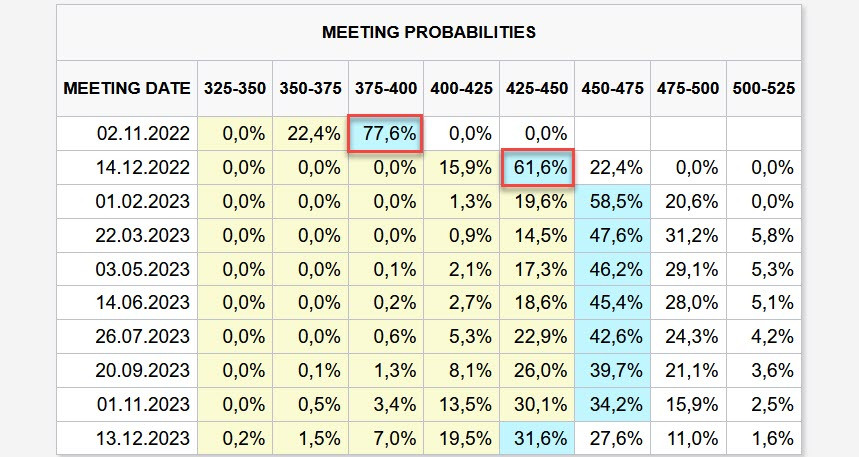
The greenback strengthened by the close of the previous week amid better-than-expected data on ISM business activity in the services sector and the labor market in September. US recession risks eased, while expectations of the hawkish Fed, on the contrary, grew.
The ISM report logged a steady expansion in the sector with a modest decrease in pace. The reading remained above 60, which is an important factor for Fed monetary policy expectations. At the same time, the employment index rose to 53 from 50 in September, the highest in six months.
Thus, following a disappointing ISM manufacturing PMI, US recession risks somewhat eased and the expectations of the hawkish Fed grew. Early on Monday, there was a 77.6% probability of a 0.75% rate hike in November. Traders are now betting on rate cuts in 2023.
Speaking of the labor market report, data also came better than expected. NonFarm Payrolls increased by 263K, above market forecasts of 255K. The results of the two previous months were also upwardly revised by 11K. Average weekly earnings rose by 0.3% month-over-month and by 5% year-over-year. New York Federal Reserve Bank President John Williams said interest rates need to rise to around 4.5% over time.
The greenback strengthened by the close of the previous trading week. When all the above-mentioned factors are priced in by the market, a bearish correction may occur. The FOMC Minutes, due on Wednesday, and consumer inflation, due on Thursday, are now seen as the main driving force for the dollar. The reading is estimated to decrease by 0.4% from a month earlier.
EUR/USD
Inflation risks in the eurozone are still high, which is now seen as the main reason behind the weaker euro. An increase in wholesale energy prices ahead of the winter season and natural gas shortages has not yet affected consumers. Retail gas and electricity prices are forecast to rise for at least another year. Europe risks sliding into a recession earlier than countries.
The EUR net long position grew by 1.4 billion to 5.4 billion during the reporting week. Despite strong spot pressure, the positioning is still bullish. This means that major players see the potential for a reversal but are not ready to give up this scenario yet. The settlement price is moving up above the long-term MA.

A week earlier, a potential target was seen at 0.9960/80, the upper limit of the channel. The price reached the target but reversed due to a number of reasons, including the strong September labor market report in the US, and the decision of OPEC+, which could trigger a crisis earlier than expected. Still, the euro has some growth potential. The nearest support level stands in the middle of the bearish channel at 0.9670/90, where buying pressure could increase. The targets are seen above 1.000 as well as above 1.0190/0200.
GBP/USD
Uncertainty is surrounding the British economy and the pound sterling. The large-scale fiscal support package proposed by the government could boost prices and average earnings. So far, it is unclear how the implementation of the plan could affect the market. It could potentially reduce demand for the pound. Some representatives of the Bank of England will give interviews this week, which could shed more light on the situation. On October 14, the Bank of England plans to cease all bond purchases. Quantitative tightening (QT) is scheduled for October 31st. It remains to be seen whether the regulator will be ready to implement its plans.
The GBP net short position reached -3.5 billion during the reporting week. Although the positioning is still bearish, the downtrend is unlikely to continue. The settlement price is noticeably higher than the spot price, which signals an impending bullish correction.
As expected, the sterling went above the technical level of 1.1264 but failed to consolidate and reach the upper limit of the bearish channel 1.1670/1720. Nevertheless, it can be assumed that the price would attempt to rise again, with support seen at the current levels of 1.1050/60 or slightly below, at 1.0910/30, and then retest the 1.15 mark, with 1.1670/1720 seen as the target.